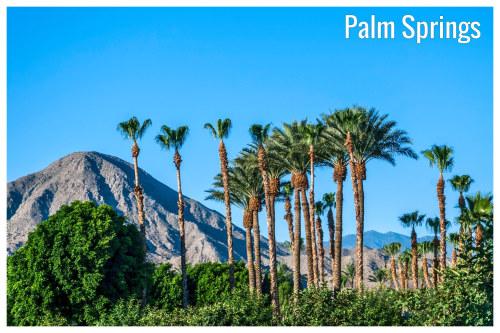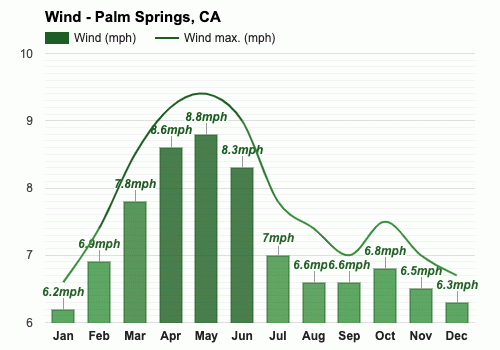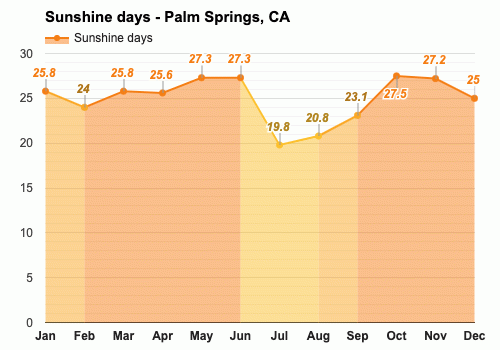Contents
- The climate of Palm Springs
- The best time to visit Palm Springs
- The worst time to visit Palm Springs
- Spring weather in Palm Springs
- Summer weather in Palm Springs
- Autumn weather in Palm Springs
- Winter weather in Palm Springs
- Weather in January
- Weather in February
- Weather in March
- Weather in April
- Weather in May
- Weather in June
- Weather in July
- Weather in August
- Weather in September
- Weather in October
- Weather in November
- Weather in December
- Frequently asked questions
- Average temperature
- Average pressure
- Average wind speed
- Average humidity
- Average rainfall
- Average rainfall days
- Average daylight
- Average sunshine
- Average sunshine days
- Average UV index
- Average cloud cover
- Average visibility

Climate and monthly weather forecast
The climate of Palm Springs
Annual weather in Palm Springs features high temperatures ranging from 59.5°F (15.3°C) to a sweltering 93.4°F (34.1°C), and lows between 43°F (6.1°C) and 72.1°F (22.3°C). Average relative humidity throughout the year stays fairly consistent, ranging between 28% and 48%.
Palm Springs sees variations in rainfall from a minimum of 0.12" (3mm) to a maximum of 0.91" (23mm). Interestingly, the city receives an average sunshine duration of 12 hours during summer which significantly decreases to around 7 hours in the winter months. Reviewing the data shows that months featuring the most rainfall do not always align with those with the least sunshine. For instance, July experiences the highest rainfall, yet it also boasts 12.1 hours of sunshine.
Strong winds are prevalent throughout the year, with average wind speeds varying from 6.2mph (10km/h) to a breezy 8.8mph (14.2km/h). The highest gusts can reach up to 12.8mph (20.6km/h).
The best time to visit Palm Springs
The worst time to visit Palm Springs
Spring weather in Palm Springs
Summer weather in Palm Springs
Autumn weather in Palm Springs
Winter weather in Palm Springs
Weather in January
Weather in February
Weather in March
Weather in April
Weather in May
Weather in June
Weather in July
Weather in August
Weather in September
Weather in October
Weather in November
Weather in December
Published by: Weather U.S. | About Us
Data Sources | Weather Forecasting & Climate
Frequently asked questions
How many days does it rain?
When is Daylight Saving Time (DST)?
What is the driest month?
When are the longest days?
What are the months with the most sunshine?
What are the months with the highest UV index?
What is the warmest month?
What is the wettest month?
What is the least humid month?
What is the coldest time of year?
What is the most humid month?
What is the month with the shortest days?
What is the month with the least sunshine?
What is the month with the lowest UV index?

Average temperature
Palm Springs, CA
The warmest months (with the highest average high temperature) are July and August (93.4°F).
The month with the lowest average high temperature is December (57.6°F).
The month with the highest average low temperature is August (72.1°F).
The coldest month (with the lowest average low temperature) is December (42.1°F).

Average pressure
Palm Springs, CA
- Average pressure in January:
30.09"Hg - Average pressure in February:
30.03"Hg - Average pressure in March:
29.99"Hg - Average pressure in April:
29.91"Hg - Average pressure in May:
29.86"Hg - Average pressure in June:
29.81"Hg
- Average pressure in July:
29.85"Hg - Average pressure in August:
29.84"Hg - Average pressure in September:
29.84"Hg - Average pressure in October:
29.92"Hg - Average pressure in November:
30.01"Hg - Average pressure in December:
30.06"Hg
The month with the highest atmospheric pressure is January (30.09"Hg).
The month with the lowest atmospheric pressure is June (29.81"Hg).

Average wind speed
Palm Springs, CA
- Average wind speed in January:
6.2mph - Average wind speed in February:
6.9mph - Average wind speed in March:
7.8mph - Average wind speed in April:
8.6mph - Average wind speed in May:
8.8mph - Average wind speed in June:
8.3mph
- Average wind speed in July:
7mph - Average wind speed in August:
6.6mph - Average wind speed in September:
6.6mph - Average wind speed in October:
6.8mph - Average wind speed in November:
6.5mph - Average wind speed in December:
6.3mph
The windiest month (with the highest average wind speed) is May (8.8mph).
The calmest month (with the lowest average wind speed) is January (6.2mph).

Average humidity
Palm Springs, CA
The month with the highest relative humidity is December (48%).
The month with the lowest relative humidity is August (28%).

Average rainfall
Palm Springs, CA
- Average rainfall in January:
0.35" - Average rainfall in February:
0.47" - Average rainfall in March:
0.31" - Average rainfall in April:
0.31" - Average rainfall in May:
0.12" - Average rainfall in June:
0.12"
- Average rainfall in July:
0.91" - Average rainfall in August:
0.67" - Average rainfall in September:
0.39" - Average rainfall in October:
0.2" - Average rainfall in November:
0.24" - Average rainfall in December:
0.51"
The wettest month (with the highest rainfall) is July (0.91").
The driest months (with the least rainfall) are May and June (0.12").

Average rainfall days
Palm Springs, CA
- Average rainfall days in January:
4.3 days - Average rainfall days in February:
3.2 days - Average rainfall days in March:
4.8 days - Average rainfall days in April:
4.1 days - Average rainfall days in May:
2.9 days - Average rainfall days in June:
1.6 days
- Average rainfall days in July:
7.3 days - Average rainfall days in August:
6.2 days - Average rainfall days in September:
5 days - Average rainfall days in October:
2.5 days - Average rainfall days in November:
1.9 days - Average rainfall days in December:
4.1 days
The month with the highest number of rainy days is July (7.3 days).
The month with the least rainy days is June (1.6 days).

Average daylight / Average sunshine
Palm Springs, CA
- Average daylight in January:
10h and 1min - Average daylight in February:
11h and 0min - Average daylight in March:
12h and 0min - Average daylight in April:
13h and 1min - Average daylight in May:
13h and 5min - Average daylight in June:
14h and 2min
- Average daylight in July:
14h and 1min - Average daylight in August:
13h and 2min - Average daylight in September:
12h and 2min - Average daylight in October:
11h and 2min - Average daylight in November:
10h and 2min - Average daylight in December:
9h and 5min
The month with the longest days is June (Average daylight: 14h and 24min).
The month with the shortest days is December (Average daylight: 9h and 54min).
- Average sunshine in January:
7h and 1min - Average sunshine in February:
7h and 1min - Average sunshine in March:
9h and 1min - Average sunshine in April:
11h and 3min - Average sunshine in May:
12h and 0min - Average sunshine in June:
12h and 1min
- Average sunshine in July:
12h and 1min - Average sunshine in August:
12h and 0min - Average sunshine in September:
10h and 3min - Average sunshine in October:
9h and 2min - Average sunshine in November:
7h and 2min - Average sunshine in December:
7h and 0min
The months with the most sunshine are June and July (Average sunshine: 12h and 6min).
The month with the least sunshine is December (Average sunshine: 7h and 0min).

Average sunshine days
Palm Springs, CA
- Average sunshine days in January:
25.8 days - Average sunshine days in February:
24 days - Average sunshine days in March:
25.8 days - Average sunshine days in April:
25.6 days - Average sunshine days in May:
27.3 days - Average sunshine days in June:
27.3 days
- Average sunshine days in July:
19.8 days - Average sunshine days in August:
20.8 days - Average sunshine days in September:
23.1 days - Average sunshine days in October:
27.5 days - Average sunshine days in November:
27.2 days - Average sunshine days in December:
25 days
The month with the most sunshine days is October (27.5 days).
The month with the least sunshine days is July (19.8 days).

Average UV index
Palm Springs, CA
The months with the highest UV index are June, July and August (UV index 7).
The month with the lowest UV index is December (UV index 3).

Average cloud cover
Palm Springs, CA
The month with the most cloud cover is December (Cloud cover 20).
The month with the least cloud cover is June (Cloud cover 5).

Average visibility
Palm Springs, CA
The months with the highest visibility are January, February, March, April, May, June, July, August, September, October, November and December (6mi).
The months with the lowest visibility are January, February, March, April, May, June, July, August, September, October, November and December (6mi).